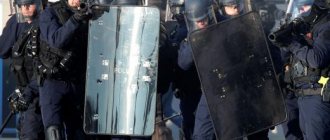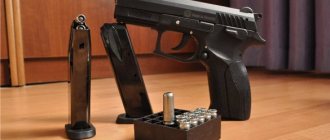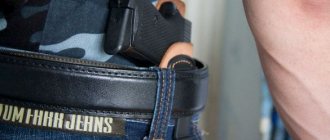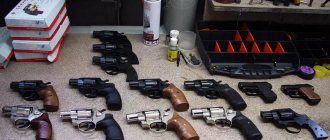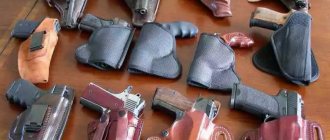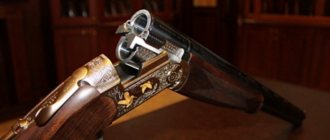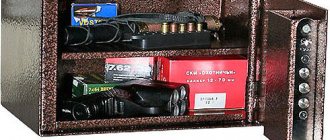The procedure established by law for obtaining permission to buy a traumatic weapon is quite clear and transparent for most owners. Of course, it has its own difficulties, but overall the scheme is intuitive. But not everyone who wants to buy a traumatic pistol has an idea of what to do with their happiness after receiving all the documents and the actual purchase. Many people do not know that when purchasing a traumatic weapon, you are also required to purchase a safe for a traumatic pistol.
An important part in the further use of the injury is the conditions of its maintenance. The law has a number of requirements in this regard, and the main one is reliability from access by unauthorized persons. Therefore, each owner will also have to purchase a safe for a traumatic pistol (or other self-defense weapon purchased by you).
Rules for storing traumatic weapons
They are practically no different from those for civilian models or hunter weapons, i.e. obviously more dangerous for others. The storage rules are that it is necessary to store traumatic weapons, as well as ammunition for them, in metal or wooden boxes/safes lined with metal, locked with a padlock and located in enclosed spaces. The main condition is burglary resistance to ensure the isolation of the purchased traumatic pistol from access to it by unauthorized persons and those who do not have the appropriate permission to use it.
In the absence of a safe for storage, you can easily and simply lose both the purchased weapon and the permit for it. It will be very difficult to regain the favor of employees of regulatory agencies. Illegal storage may even lead to administrative or criminal liability.
Punishment for breaking the law
The rules for the circulation of civilian and service weapons cannot be violated - this is fraught with serious consequences. Punishments are prescribed in the Code of Administrative Offenses of the Russian Federation:
- violated the rules for carrying traumatic or other weapons - a fine (500–2000 rubles) or deprivation of the right to own a weapon for up to six months;
- bought or transferred to the buyer a “left” gun - a fine (3000–5000 rubles) with confiscation or arrest for 5–15 days;
- installed a sight or a silencer - a fine of 2000–2500 rubles. with confiscation of this device;
- manufactured or sold pneumatics - a fine of 1000–5000 rubles. with confiscation;
- expired weapons permit - warning, fine 1000–3000 rubles;
- illegally used – fine 1500–3000 rubles;
- shot in the air on the street and scared passers-by - a fine of 2000–5000 rubles. and weapons confiscation.
What types of safes are there?
All safes are classified according to their purpose. According to the differences in dimensions, safe sizes come in two main types:
- Pistol - small, reliable storage for a variety of short-barreled weapons, including traumatic weapons;
- Gun safes are large boxes that can easily accommodate long-barreled carbines and shotguns. As a rule, they have a lot of useful things inside, for example shelves or even separate sections with an additional closed door for cartridges
Each of the presented types is usually a reliable metal box, or a professionally made safe with multi-level protection against fire, drilling of locks, and so on.
For budget options, there are wooden safes lined with iron. The law does not prohibit having such storage facilities, but inspectors will always have questions about the reliability of such a safe. If you want to save your time on explanations and really make a safe place to store your weapons, then it is better to think about purchasing a full-fledged metal box.
If you are going to save money, then do it on size, not on quality characteristics. Internal dimensions for storing trauma items are not so important. Almost all samples are very compact. Storage of ammunition for it will not take up much space either.
How to store trauma
Without knowing the rules for storing traumatic weapons at home, it is impossible to talk about any requirements. Let's start with the fact that the presence of a safe guarantees the signing of the act by the district police officer. Without this document it is impossible to obtain permission. But the main purpose of the safe is to ensure the inviolability of weapons by strangers.
When storing a hunting rifle in a gun safe, the cartridges must be kept in a separate compartment. There is no such requirement for trauma weapons, but you need to think ahead about the possibility of purchasing a second barrel. So when purchasing, you should choose those options that, in terms of their size, will allow you to store not only a pistol, but also a gun. It may be noted that this guidance is not legislative, but advisory in nature.
Safe characteristics
Now let’s look at what kind of safe you need for a traumatic pistol. What are its main characteristics, and other data that the models in question need to have to meet the requirements of inspection structures. There are not many of them and many of them are spelled out very vaguely. In many matters, the decision about the suitability or unsuitability of a cabinet for the secure preservation of weapons will depend on the personal conviction of the examiner in this regard. Let's consider the issues that they will definitely pay attention to.
The wall thickness of metal storage cabinets is not specified in regulatory documents. Taking advantage of this, manufacturers of budget safe models have flooded the market with samples with a metal thickness of 1.2-1.5 mm. They are not prohibited for use and are in demand among many owners. However, the reliability of such a safe, especially if it is equipped with a simple lock, can raise a lot of questions from the inspector.
According to oral recommendations from employees of the department that ensures the storage of traumatic weapons, models with a wall thickness of at least 2 mm are reliable. When purchasing such models, a long conversation in order to convince an authorized person of the reliability of the safe will no longer be necessary.
Another integral part of safely storing your gun is a secure lock. Among the simple, inexpensive and quite effective ways to protect your safe door is a mortise key lock. Many owners prefer this classic option. In addition, its warranty is much longer than that of more modern versions of locking devices. But it has several fundamental problems:
- The need to keep the key from falling into other hands, especially children's. Possession of it gives full access to the contents of the safe;
- Even if the key is in a safe place, an attacker with a fair amount of skill will be able to open a simple lock with master keys or somehow obtain a copy of your key. And this brings us back to the first point.
Another option is offered by electronic locking devices. They do not need a key and the variety of mechanisms and systems for opening them using unconventional methods leaves a minimum of chances. The key to discovery is the knowledge of the owner himself. He chooses the password himself and can easily change it if necessary. All that remains is to monitor the serviceability of the batteries and change them in a timely manner. If you missed the moment and the castle sat down, there is no need to worry. Each lock has its own methods of resuscitation, but not one of them will allow you to open the lock without entering a password. The downside of such locks is the cost. And if simple combination locks can only slightly exceed the price of good key models, then samples with biometric data scanners raise this bar high.
Correct installation of the safe
To ensure the main requirement of the law - to ensure that unauthorized persons cannot access the contents of the safe, it is important to install it correctly in the premises. To ensure this measure, there are several requirements on how to properly store weapons at home. Compliance with them is mandatory for all existing owners of traumatic weapons, as well as those wishing to purchase them. Among them are the following points:
- It is necessary to install a safe and store non-purchased traumatic weapons at the registration address of the person who has samples of such weapons in his use, or at his place of permanent residence. The safe itself must be installed in a secure room (for example, closed with a steel door, or in another way that limits access to unauthorized persons). In this case, and especially when installing a safe in public rooms, it should be firmly fixed in place, screwed or mounted into the wall, and, if possible, hidden from prying eyes as much as possible. Only one person - the owner - should have the code for the lock or the key to it;
- Persons who collect samples of traumatic weapons (if they own more than 6 copies) will have to approach the issue of protection even more responsibly. In addition to the mandatory presence of a steel door to the storage room, a fire and security alarm must also be installed in it. If the room has windows, and the room itself is located on the extreme (first and last) floors of the building, then they are covered with metal bars;
- If the owner of the weapon is a legal entity, then they are subject to requirements similar to collectors, with the addition of the requirement to store ammunition separately from the weapon itself, in different metal boxes. Moreover, the thickness of the walls of the compartments for cartridges cannot be less than 3 mm. Compliance with this requirement is monitored very strictly, so it is not advisable to risk your license for the sake of savings.
General provisions
Is it possible to store weapons at home? The requirements and rules corresponding to this issue in relation to individuals are set out in the Law “On Weapons” of 1996 in Article 22 “Storage of service and civilian weapons, as well as ammunition for them.”
According to the standards for storing traumatic weapons, only citizens who have a special permit have the right to store them at home. It should be noted that weapons, the acquisition of which is possible without registration with the Department of Internal Affairs and a license, can be stored without documented permission. Thus, in certain cases, without registration and a license, it is still possible to organize the storage of weapons at home. The relevant types include the following:
- Specialized products whose design is similar to that of a weapon.
- Pistols and rifles with a muzzle energy of three joules, as well as air revolvers.
- Revolvers with a caliber of up to six millimeters, as well as cartridges for them.
- Signal pistols.
conclusions
These are the main points that all owners of self-defense weapons should pay attention to. It is a pity that many of them try to fulfill only a minimum set of conditions. There is a very harmful opinion that the main thing is to get a license and buy a weapon, and the safe and storage requirements are a secondary matter. This is fundamentally wrong.
It is important to remember that by complying with these simple requirements, you will not only free yourself from problems with the law, which naturally no one needs, but will actually make the storage of high-risk items reliable. This is especially true if there are children in the house.
If the permit is refused
If all conditions provided by law are met, obtaining a license will not take a long time. To speed up the procedure somewhat, you can contact specialized commercial centers that organize the collection of documents for a license.
However, the absolute grounds for refusal to issue a special permit are:
- age less than 21 years, there are contraindications related to health conditions or the exam has not been passed;
- persons who do not have a specific place of residence;
- there are violations of hunting rules;
- a conviction for committing an intentional crime of any nature has entered into legal force. The type of punishment does not play a significant role in this case, while at the same time, only the outstanding criminal record matters for refusal;
- committing, within 12 months by the time of applying for a license, at least two administrative offenses related to an encroachment on administrative order (or public order);
- prisoners who, at the time of applying for permission, are serving a sentence of imprisonment for committing a crime.
For example, all the necessary documents sufficient to obtain a permit have been collected. But the appeal was later, say, a year later. The issuance of a license will be refused due to an expired medical report (valid for 1 year).
If the issuance of a license is refused unreasonably, the actions of LRO employees are appealed to the court. Such cases are isolated, since an exhaustive list of requirements for the recipient of a license eliminates any ambiguities in the application of the law.
